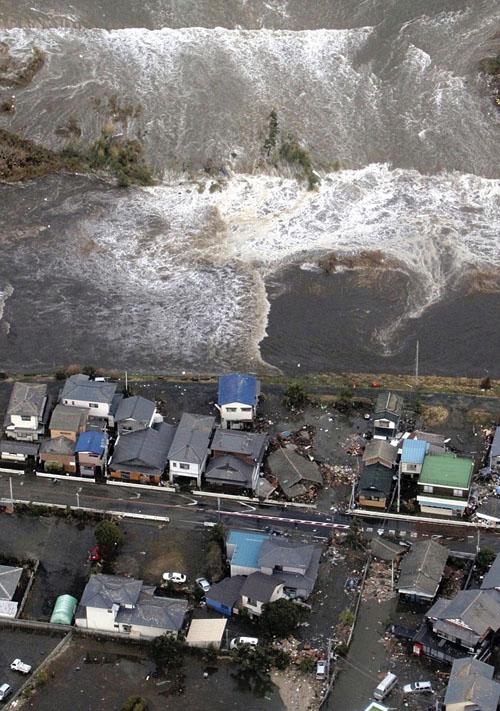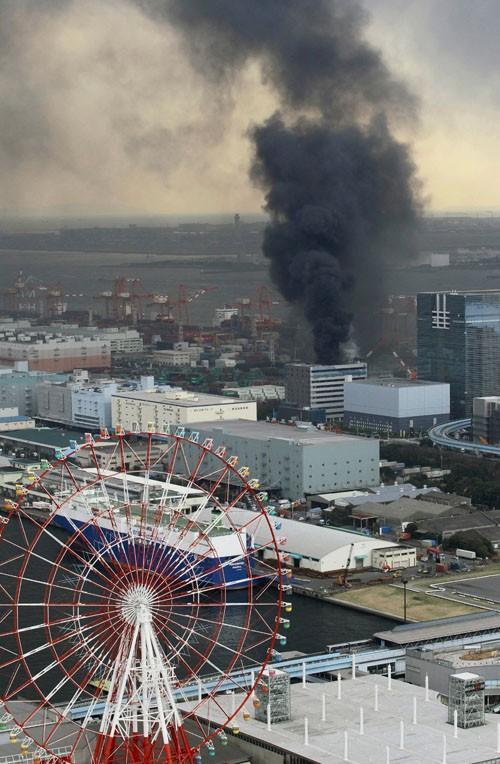
A tsunami approaches seashore houses in Kita Ibaraki, Ibaraki Prefecture, northeast of Tokyo, Friday, March 11, 2011 after the largest earthquake in Japan’s recorded history slammed the eastern coast. (AP Photo/The Yomiuri Shimbun, Yasushi Nagao)
Dedman College Dean William Tsutsui was on a bus outside a major hotel in Tokyo when the ground started to shake.
“I lived in Japan in the past so I’ve experienced plenty of earthquakes, but this was an entirely new level of violence in an earthquake,” he said during a phone interview that took place at approximately 3 a.m. Japan-time. “We looked outside the bus and people were running out of the hotel.”
Tsutsui said he looked up at the skyscrapers and “they were swaying like trees in the wind.”
Japan suffered its biggest recorded earthquake to date on Friday just off its eastern coast. The magnitude-8.9 quake triggered a 23-foot tsunami that has killed hundreds of people and started widespread fires.
The Associated Press reported as of 1:30 p.m. that 200-300 bodies were found in Sendai, a northeastern coastal city that was closest to the earthquake’s epicenter, along with another 151 confirmed deaths.
Police told the AP that 547 people were reported missing and 798 have been injured.
SMU did not have any students studying abroad in Japan this semester, according to the Study Abroad Office.
Tsutsui had been traveling in Japan with the Japanese American Leadership Delegation, which was seeking to further U.S.-Japan relations.
Tsutsui said most of the people on his bus were in shock.
“We couldn’t believe we were in this situation, and you know, none of us had any idea what was going to happen,” he said. “We didn’t know if the windows were going to start popping out of the buildings or if the skyscrapers that were swaying were going to fall down.”
SMU alumna Ayaka Suzuki (’10) was at home near downtown Tokyo when the quake hit.
“By a stroke of luck, I had the day off from work and I was at home shopping online with my mother,” she wrote in an email interview. “If I had gone to work, I would have surely been stranded.”
Suzuki has lived in Japan for six years and said that most of her family lives there. She’s still waiting to hear from her grandmother in the Kanagawa prefecture and a good friend who was flying into Haneda Airport. Everyone else is unhurt.
“I am worried about people I can’t seem to get in touch with,” she wrote. “BBM and Twitter served as great lifelines to stay in touch with friends all over the world; that was definitely a blessing to have but it didn’t take long after the earthquake for the service signals to become very iffy and on/off.”
Scientists told the AP that the quake “ranked as the fifth-largest earthquake in the world since 1900 and was nearly 8,000 times stronger than one that devastated Christchurch, New Zealand, last month.”
President Barack Obama pledged U.S. assistance for Japan on Friday.
Tsutsui said he was amazed at how quickly everything went back to normal in Japan, which is a couple of hundred miles from Sendai. After the group made sure they were ok, they went on to the meeting they had scheduled with some business leaders.
“It was only later then that I think everyone began to realize the incredible damage caused by the tsunami in Northern Japan and how much life was going to be disrupted here in Tokyo,” he said.
Suzuki described how transportation in Japan had halted, causing people to walk many hours just to get home. Suzuki said Japan Rail had been shut down for the day, causing trouble for commuters, and that the subway was only started back up. The roads were crowded enough to make taking the bus useless.
“It’s just scary, there are still plenty of people staying the night in local high school gyms and municipal buildings because they’re unable to get home.”
Both Suzuki and Tsutsui praised Japan’s building codes, which are designed to minimize damage during an earthquake. The country sits on a area that has frequent earthquakes.
“Seeing buildings move like that, it’s hard to believe they didn’t break or fall down,” Tsutsui said. “And having seen the effects of earthquakes in places like Haiti and New Zealand on the news, the kind of shaking that took place here in Tokyo—it is phenomenal that there wasn’t more destruction or more people hurt.”
Tsutsui had planned to fly back to Dallas tomorrow.
“I still have a little bit of hope that I might be able to get out, but I expect that it will be a day or two before I can come back to Dallas,” he said.

Black smoke rises from a burning building in Tokyo after Japan was struck by a magnitude 8.9 earthquake off its northeastern coast Friday, March 11, 2011. (AP Photo/Kyodo News)









